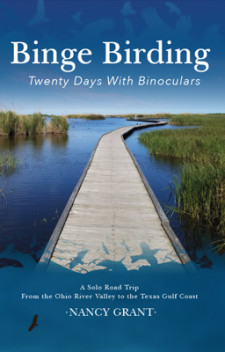Reviewed by Grant McCreary on December 30th, 2019.
Relatively early in my birding life I read two books that captured my imagination even more than all those wonderfully new birds in my field guide. The Feather Quest, by Pete Dunne, and Kenn Kaufman’s classic Kingbird Highway introduced me to exotic birds and far-flung locations. More importantly, though, they instilled a desire in me to follow in their authors’ footsteps, to travel to those places and see those birds. Nancy Grant’s Binge Birding: Twenty Days with Binoculars has the potential to do the same.
In Binge Birding, Nancy takes us along on a 20-day road trip from her home in Kentucky to South Texas, birding all along the way. She visits famous birding locales such as High Island, Texas, as well as many less-well-known spots in Alabama, Louisiana, and, especially, Texas. This is an absolutely wonderful, birdy region, and that shines through in these reports.
Yes, this is essentially an extended version of a trip report. But it’s quite different from your average internet trip report. First and foremost, it’s quite well-written. The author keeps the narrative flowing and the reader engaged. It would have been really easy for this book to be a tedious and repetitious read – get up, go birding, go to bed, repeat. Nancy avoids this by adding additional details about the birds; it’s not just a list of those that she comes across, but some information about them as well. She also includes non-birding aspects of her day, such as a few touristy activities, lodging, and, especially, food. This adds just enough needed variety.
Binge Birding is also different from most other birding travel books. Nancy doesn’t hide the fact that she can’t initially identify all the birds she comes across, although she’s able to work most of them out eventually. Many of the birds she encounters are lifers, and she has to work out the identification. In some cases, she has to go back over her photos with a field guide. The authors of most birding narratives rarely seem to struggle over an identification…or at least rarely admit it. This is a refreshing change – after all, we’re not all experts and not every bird is instantly identified.
In the same way, the author also has a distinctly different pace than those of other, similar books. She is deliberate, not rushing from place to place. Nor does she prioritize chasing new birds, preferring instead to check out a wide variety of habitats and let the birds come to her. This is, of course, in stark contrast to ‘big year’ books in which the participants try to find as many birds as possible within a certain location and amount of time. Being freed from this framework also allows Nancy to be interested in more than identification. She often stops to ponder what the birds are doing, and why.
Reading Nancy’s story, I found that her pace and, to some extent, philosophy of birding differed greatly from mine. When traveling, especially solo, I tend to cover much more distance at a time than Nancy was willing to. I try to fit more into a day, birding during the daylight hours and then eating dinner or traveling after dark. Our attitudes toward new and rare birds differ even more. I am by no means a hardcore twitcher, but if I’m birding a new area I prioritize trying to find new birds and will make a concerted effort to see any rare birds that are around. Nancy did not even care to know of any rarities in her vicinity, much less make an explicit attempt to see them. I say this not to hold up one way of birding as better than another. Actually, quite the opposite. There is no one, “right” way to bird, and following along with Nancy in Binge Birding was a great reminder of that for me. She writes:
That’s what’s so appealing about birding – people can set their own goals. I have friends who want to see every kind of warbler possible each spring, and other friends who are fascinated by hummingbirds. And I know several people who will drive hundreds of miles just to see owls. I know birders who count how many different species they can find in a single county during a year, and others who don’t keep lists at all…
As for me, during this trip I’m trying to understand which kinds of birds prefer each of the habitats I’m exploring, which are different in many ways from what I know in the Ohio River Valley.
All of these aspects of Binge Birding – the format, scope, writing style, author’s birding style – should make this appeal greatly to newer birders. Readers can vicariously explore some of the greatest birding areas of the United States. They will likely learn a bit as well, such as the unconventional, for a warbler, nesting habits of the Prothonotary Warbler, as well as the origin of its name. And for those who have not yet undertaken such a trip, they will see how such a thing is possible for anyone to do.
Recommendation
Those who have never been to Texas’ gulf coast will learn a great deal about this area and its special birds through Nancy Grant’s solo road trip recounted in Binge Birding: Twenty Days with Binoculars. What is more, the book has the potential to inspire those who have never done so to travel somewhere new, whether that is the gulf coast of Texas or elsewhere, and seek out some new birds. Don’t be surprised if, after reading this, you end up like Nancy does at the end of the tale – planning your next trip.
Disclosure: I get a small commission for purchases made through links in this post.
Disclosure: The item reviewed here was a complementary review copy provided by the author. But the opinion expressed here is my own, it has not been influenced in any way.



Comment